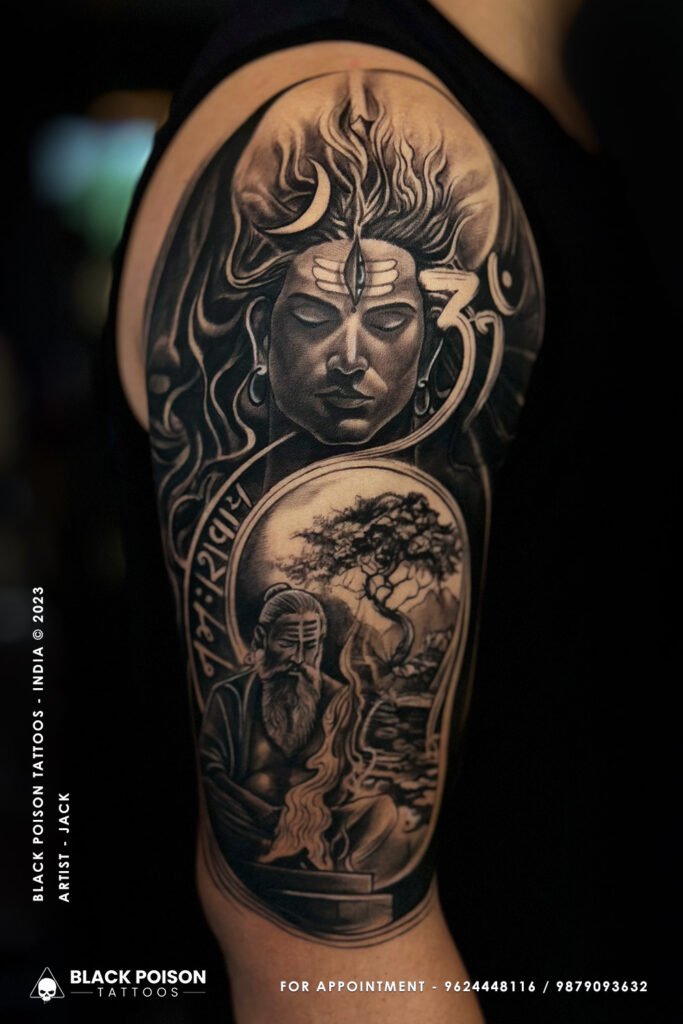The world of Hindu symbolism offers a treasure trove of imagery for meaningful tattoos. Among these, the Trance of Shiva & Rishi tattoo stands out as a powerful representation of inner transformation and spiritual guidance. This blog post delves into the symbolism behind this unique design, exploring its historical significance and potential interpretations for the modern wearer.
The Dance of Destruction and Renewal
Shiva, the Hindu god of transformation, is often depicted in the ecstatic dance of Tandava. This cosmic dance represents the continual cycle of creation, destruction, and renewal within the universe. The Trance of Shiva & Rishi tattoo frequently features Shiva in this dynamic pose, his body adorned with serpents and flames, symbolizing the transformative power he wields.
The Guiding Presence of the Rishi
Juxtaposed against Shiva’s energetic dance is the serene figure of a Rishi, a wise sage or seer. The Rishi acts as a counterpoint to Shiva’s dynamism, representing the wisdom and guidance needed to navigate the transformative process. In the tattoo, the Rishi is often depicted in a meditative posture, offering a sense of grounding and spiritual insight.
Unveiling the Layers of Meaning
The Trance of Shiva & Rishi tattoo resonates with wearers on multiple levels. Here’s a deeper look at the symbolism it embodies:
- Transformation and Rebirth: Shiva’s dance signifies the constant change inherent in life. By incorporating this image, the wearer acknowledges their own journey of growth and transformation.
- Inner Power and Destruction of Ego: The flames surrounding Shiva represent the burning away of illusion and ego. The tattoo serves as a reminder of the potential for immense inner power that lies within each of us.
- Seeking Guidance and Wisdom: The Rishi embodies the wisdom and knowledge needed to navigate life’s challenges. The tattoo signifies the wearer’s openness to guidance and spiritual growth.
- Balance and Duality: The contrasting figures of Shiva and the Rishi represent the inherent duality within the universe – destruction and creation, chaos and order. The tattoo serves as a reminder of the importance of finding balance within oneself.
Beyond Symbolism: Personal Interpretations
The beauty of the Trance of Shiva & Rishi tattoo lies in its ability to hold personal meaning for the wearer. Some interpretations include:
- A Commitment to Spiritual Growth: The tattoo can symbolize a dedication to self-discovery and a willingness to embrace life’s transformative experiences.
- Overcoming Challenges: It can represent the courage to face inner demons and emerge stronger from difficult times.
- Honoring Lineage and Tradition: The Rishi can signify a connection to one’s spiritual lineage or a particular guru who has offered guidance.
Considering the Design
The Trance of Shiva & Rishi tattoo can be rendered in various artistic styles, from traditional Hindu art forms like Kolam or Madhubani to contemporary black and grey or vibrant illustrative styles. The choice of style ultimately depends on the wearer’s personal preferences and the desired level of detail.
Placement and Size
The size and placement of the tattoo can also hold significance. A larger, more elaborate design on the back or chest can represent a deep commitment to the symbolism, while a smaller, more discreet piece on the arm or ankle might offer a more personal reminder.
Finding the Right Artist
Given the intricate nature of the design, choosing a skilled tattoo artist with experience in Hindu iconography is crucial. Look for an artist who can capture the essence of the symbolism and translate it into a visually stunning and culturally respectful tattoo.
Conclusion: A Powerful Talisman for Inner Transformation
The Trance of Shiva & Rishi tattoo is more than just a decorative piece of body art. It’s a powerful symbol that can serve as a constant reminder of the transformative potential within each of us. By understanding the rich symbolism behind this design, you can embark on a journey of self-discovery and embrace the power of inner transformation.



